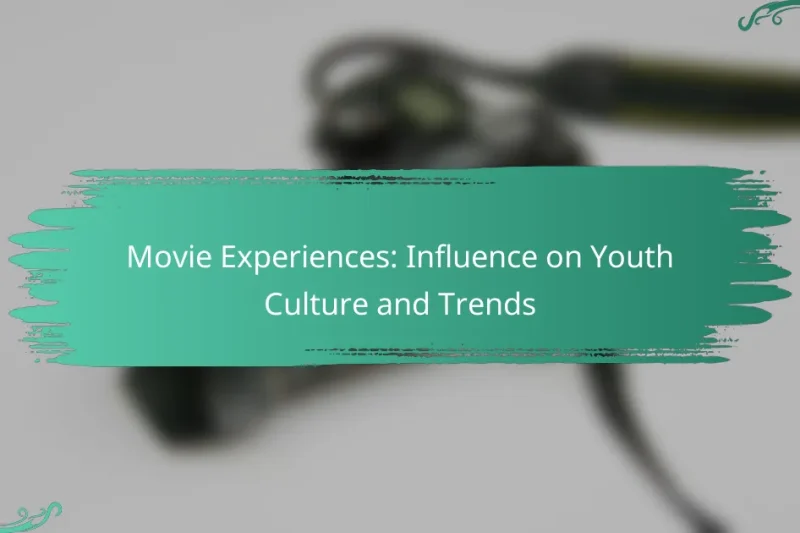Documentaries play a crucial role in raising public awareness by presenting compelling narratives that highlight pressing … Documentaries: Public Awareness and Movie Experience InfluenceRead more
Cultural Impact of Movie Experiences
The cultural impact of movie experiences extends beyond entertainment, shaping societal values and individual identities. Through powerful storytelling, films influence perceptions and foster empathy, while film festivals serve as vital platforms for diverse narratives and discussions on pressing social issues. This interplay between cinema and culture highlights the profound role movies play in reflecting and shaping our collective consciousness.
International Cinema: Cultural Importance and Unique Experiences
International cinema plays a vital role in showcasing the rich tapestry of cultural values and traditions … International Cinema: Cultural Importance and Unique ExperiencesRead more
Film Festivals: Shaping Perceptions and Movie Experiences
Film festivals play a pivotal role in shaping audience perceptions by highlighting unique storytelling and diverse … Film Festivals: Shaping Perceptions and Movie ExperiencesRead more
Movie Experiences: Influence on Youth Culture and Trends
Movies play a pivotal role in shaping youth culture by influencing trends, attitudes, and social behaviors. … Movie Experiences: Influence on Youth Culture and TrendsRead more
How do movie experiences influence cultural identity in the United States?
Movie experiences significantly shape cultural identity in the United States by reflecting and reinforcing societal values, beliefs, and narratives. Through storytelling, films can influence how individuals perceive themselves and others within a diverse cultural landscape.
Representation of diverse cultures
Films often serve as a mirror to society, showcasing a variety of cultural backgrounds and experiences. When diverse cultures are represented authentically, it fosters understanding and appreciation among audiences, helping to break down stereotypes. For instance, movies like “Black Panther” and “Crazy Rich Asians” have highlighted the importance of representation, allowing viewers to see themselves reflected on screen.
However, misrepresentation can lead to harmful stereotypes and cultural appropriation. Filmmakers should strive for accuracy and sensitivity in their portrayals to ensure that cultural narratives are respected and celebrated.
Impact on community narratives
Movies can shape and influence community narratives by telling stories that resonate with local experiences and histories. They can highlight social issues, promote dialogue, and inspire action within communities. For example, films addressing themes of social justice or environmental concerns can mobilize audiences and foster community engagement.
To maximize this impact, filmmakers and community leaders can collaborate to create projects that reflect local stories and values. This partnership can ensure that the narratives presented are relevant and meaningful, ultimately strengthening community identity and cohesion.
What are the psychological effects of movie experiences?
Movie experiences can significantly impact viewers psychologically, influencing emotions, thoughts, and behaviors. These effects can range from temporary mood changes to long-lasting shifts in attitudes and empathy.
Emotional engagement and empathy
Movies often evoke strong emotional responses, allowing viewers to connect with characters and narratives on a personal level. This emotional engagement can enhance empathy, as audiences may find themselves understanding and sharing the feelings of others, even those from different backgrounds.
For instance, a film depicting social issues may prompt viewers to reflect on their own beliefs and foster a deeper understanding of the struggles faced by others. This can lead to increased compassion and a desire for social change.
Influence on behavior and attitudes
Films can shape behavior and attitudes by presenting specific values, norms, and lifestyles. Viewers may adopt new perspectives or modify their actions based on the characters they admire or the situations they witness on screen.
For example, a movie showcasing the benefits of environmental conservation might inspire viewers to adopt more sustainable practices in their daily lives. However, it is essential to critically assess the messages conveyed, as not all portrayals are accurate or beneficial.
How do film festivals shape cultural discourse?
Film festivals play a crucial role in shaping cultural discourse by providing a platform for diverse voices and narratives. They facilitate discussions around social issues, artistic expression, and cultural representation, influencing public perception and dialogue.
Showcasing independent films
Film festivals often prioritize independent films, which may not receive mainstream distribution. This focus allows filmmakers to present unique stories that reflect underrepresented perspectives, fostering a richer cultural landscape.
For instance, festivals like Sundance and Cannes highlight innovative works that challenge conventional storytelling. By showcasing these films, festivals encourage audiences to engage with new ideas and cultural narratives.
Facilitating cultural exchange
Film festivals serve as a hub for cultural exchange, bringing together filmmakers, critics, and audiences from various backgrounds. This interaction promotes understanding and appreciation of different cultures through cinema.
Events such as the Toronto International Film Festival and Berlin International Film Festival attract global participants, creating opportunities for networking and collaboration. Attendees can experience films from diverse regions, enhancing their cultural awareness and fostering dialogue around global issues.
What role do blockbuster films play in shaping societal values?
Blockbuster films significantly influence societal values by popularizing certain ideologies and reflecting current social issues. These films often serve as a mirror to the culture, impacting public perception and behavior through their narratives and characters.
Promotion of mainstream ideologies
Blockbuster films frequently promote dominant cultural ideologies, reinforcing ideas about success, morality, and social norms. For example, films that depict the “American Dream” often highlight themes of individualism and perseverance, encouraging audiences to aspire to similar ideals.
These movies can shape public attitudes toward various topics, such as gender roles or consumerism. By showcasing specific lifestyles and values, they can normalize certain behaviors and beliefs, making them more acceptable within society.
Reflection of contemporary issues
Blockbuster films often reflect pressing social issues, providing commentary on topics like race, inequality, and environmental concerns. For instance, films that address climate change can raise awareness and prompt discussions among viewers, influencing public opinion and policy debates.
Moreover, these films can serve as a platform for underrepresented voices, helping to highlight diverse perspectives. By tackling contemporary issues, blockbuster films can foster empathy and understanding, encouraging audiences to engage with the world around them.
How can local cinemas foster community engagement?
Local cinemas can foster community engagement by serving as cultural hubs that host events and create inclusive environments for diverse audiences. By offering a space for social interaction and cultural exchange, cinemas can strengthen community ties and enhance the movie-going experience.
Hosting cultural events
Hosting cultural events, such as film festivals, themed screenings, or local filmmaker showcases, can attract a wide range of audiences and promote local talent. These events not only provide entertainment but also encourage discussions around cultural themes and issues relevant to the community.
For example, a cinema might organize a monthly foreign film night, featuring films from different countries, paired with discussions led by local cultural experts. This approach can deepen viewers’ understanding of various cultures and foster a sense of belonging.
Creating inclusive viewing experiences
Creating inclusive viewing experiences involves ensuring that all community members feel welcome and represented. This can be achieved by offering screenings with subtitles, audio descriptions, and accessible seating options for individuals with disabilities.
Cinemas can also host special events for underrepresented groups, such as [censured] film nights or family-friendly screenings that cater to diverse backgrounds. By actively promoting inclusivity, cinemas can build a loyal audience and enhance community cohesion.
What are the emerging trends in immersive movie experiences?
Emerging trends in immersive movie experiences include the integration of advanced technologies like virtual reality and interactive storytelling. These innovations enhance viewer engagement by allowing audiences to participate actively in the narrative, creating a more personalized experience.
Virtual reality film experiences
Virtual reality (VR) film experiences transport viewers into a three-dimensional world, allowing them to explore settings and interact with characters. This technology typically requires a VR headset and can range from short films to full-length features, often designed to be experienced in a dedicated space.
Key considerations for VR films include the need for high-quality graphics and sound to create a believable environment. Filmmakers must also consider user comfort, as prolonged use can lead to motion sickness. Examples of popular VR films include “The Invisible Man” and “Wolves in the Walls,” which showcase the potential of immersive storytelling.
Interactive storytelling techniques
Interactive storytelling techniques allow audiences to influence the direction of the narrative through their choices. This approach can be seen in platforms like Netflix, which has experimented with interactive films such as “Black Mirror: Bandersnatch,” where viewers make decisions that affect the plot outcome.
When implementing interactive storytelling, creators should focus on providing meaningful choices that enhance the narrative rather than distract from it. Balancing the number of choices and their impact on the story is crucial; too many options can overwhelm viewers, while too few can limit engagement. Successful interactive experiences often feature branching storylines that encourage multiple viewings to explore different paths.
How do streaming platforms affect cultural consumption?
Streaming platforms significantly reshape cultural consumption by providing instant access to a vast array of films and series from around the world. This accessibility influences viewing habits, preferences, and even cultural trends as audiences engage with diverse content.
Access to global cinema
Streaming platforms have democratized access to global cinema, allowing viewers to explore films from various countries without geographical limitations. Services like Netflix, Amazon Prime, and Disney+ offer curated selections that include international titles, often with subtitles or dubbing options.
This access encourages cultural exchange and broadens viewers’ perspectives, exposing them to different storytelling styles and cultural narratives. For instance, a user in the United States can easily watch a critically acclaimed film from South Korea or a documentary from Brazil, enriching their understanding of global cultures.
However, viewers should be mindful of the potential for algorithm-driven content recommendations to create echo chambers, where they may miss out on diverse genres and viewpoints. Actively seeking out films from various regions can help counteract this trend and enhance cultural appreciation.



